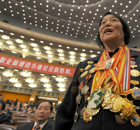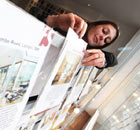-
-
China Daily E-paper
From Overseas Press
Shanghai World Expo showcases China's soft power
(Agencies)
Updated: 2010-04-28 10:42
 |
Large Medium Small |
Near the center of the World Expo grounds, the crimson-painted, crown-shaped China Pavilion towers over other nations' exhibits as a physical display of the country's pride and growing power.
Just as the Beijing Olympics showed China's growing economic and geopolitical influence for a few weeks in 2008, the biggest World's Fair ever will let China's communist leaders showcase design, tourism and cultural diplomacy over six months.
"Many ultranationalists hope Beijing will show its hard power, but the government is still very careful. The Expo is a very safe way for them to show China's soft power," says Ding Xueliang, a China expert at Hong Kong's University of Science and Technology.
The expo opening May 1 in Shanghai is expected to attract 70 million visitors, including an estimated 5 million foreign tourists.
China is far from the first power or would-be power to use an Expo to announce its global arrival.
The Great Exhibition of 1851 in London marked the coming of the Industrial Revolution. The 1970 Expo in Osaka, following the 1964 Tokyo Olympics, showed Japan's rise as an industrial power.
During the heyday of the first World's Fairs, China was either poor or preyed upon by foreign colonial powers. For many Chinese, the Shanghai Expo site is a modern, nationalist counterpoint to the colonial buildings down river on the historic Bund.
The China Pavilion, standing 207 feet (63 meters) tall, resembles an ancient crown and is painted the same red as Beijing's imperial palace. It overlooks the eastern half of the Expo grounds, 2 square miles (5.28 square kilometers) straddling the tea-colored Huangpu River.
Many of the other pavilions are more eye-catching in design and better illustrate the Expo's theme of "Better City, Better Life." But only the China Pavilion dominates. The brilliant blue strobes shooting into the overlit night sky can be seen for miles.
The Expo sits atop former steel works and shipyards and spurred a lavish upgrade of Shanghai's crumbling infrastructure. New subways, roads, bridges, tunnels were built to accommodate the crowds. Derelict neighborhoods were replaced by parks, office towers and chic shopping centers. Landscape lighting, fresh paint and extravagant floral displays added the finishing flourishes.
The message: "China is doing better and better. There is no limit to what China can do," says Shen Dingli, director of the Center for American Studies at Shanghai's Fudan University. "It is a form of power, the power of persuasion rather than of gunpowder."
The first trial run this past week brought complaints of crowds, confusion and a lack of food, though by the week's end operations improved and many took the glitches in stride.
"We just wandered around. It's nice to look at from the outside, so we just took photos and walked," said one young mother, who gave only her surname, Liu, as she headed home with her young son.
As a head-turning event, the Expo complements China's campaign to be influential through sports programs, humanitarian aid and cultural and language centers around the world.
The Shanghai event has ducked many controversies that preceded the 2008 Beijing Olympics, such as the triumphant round-the-world Olympic torch relay that was thwarted by persistent protests over Beijing's crackdown on a Tibetan uprising. Expo organizers had considered something similar — a round-the-world "friendship boat" — but dropped the idea.









